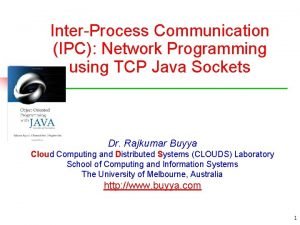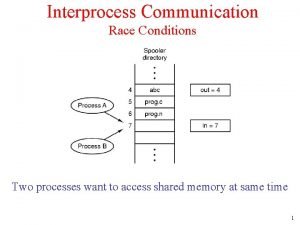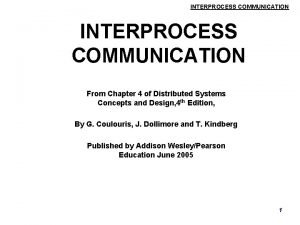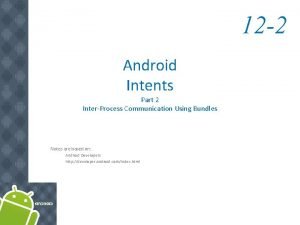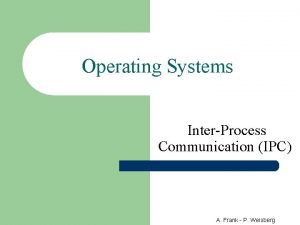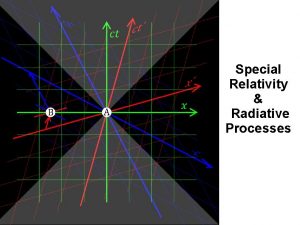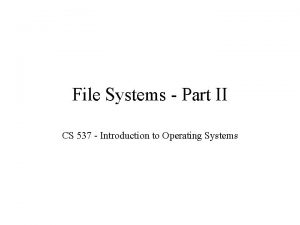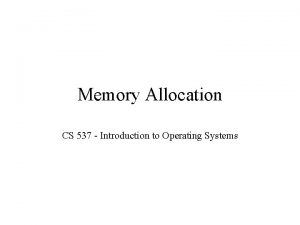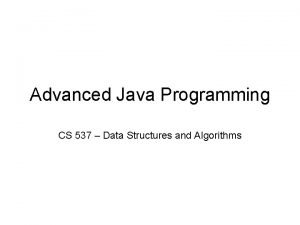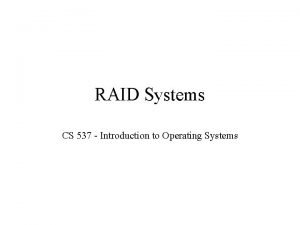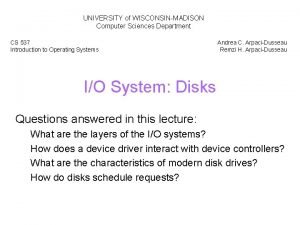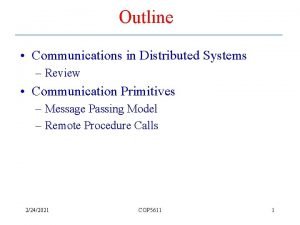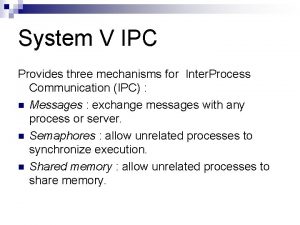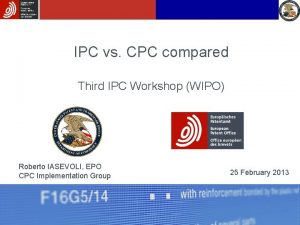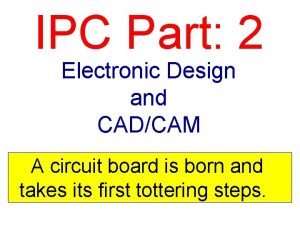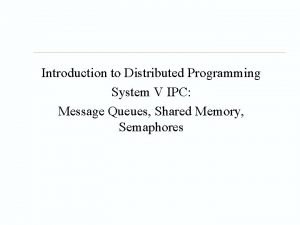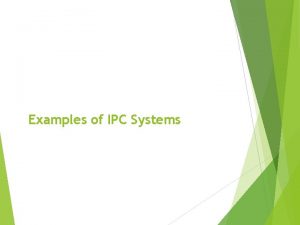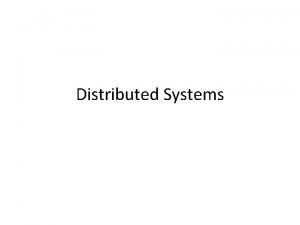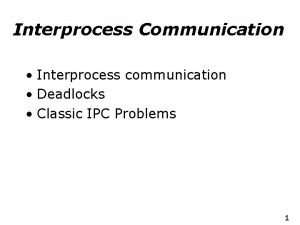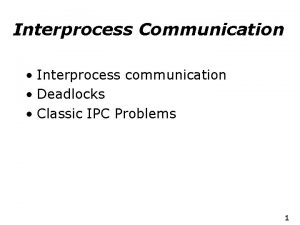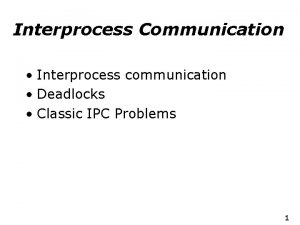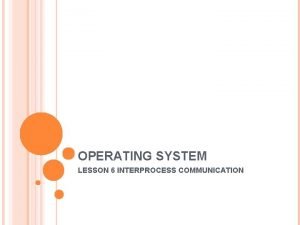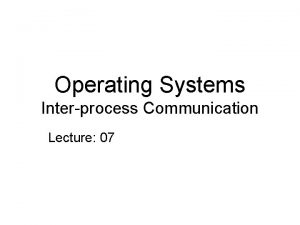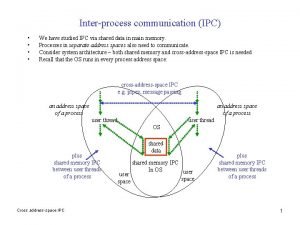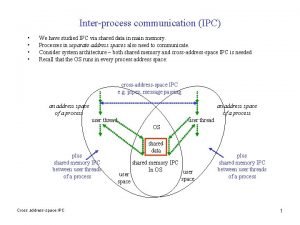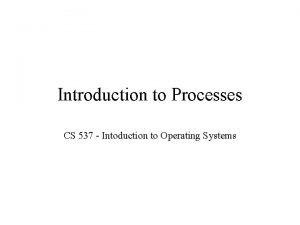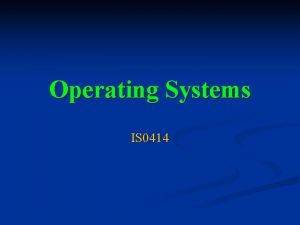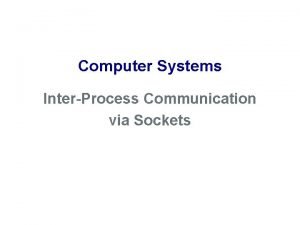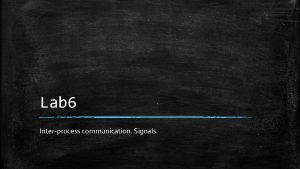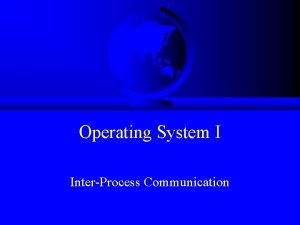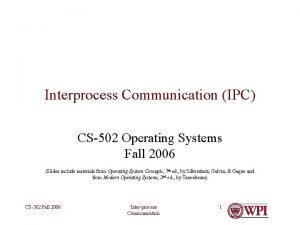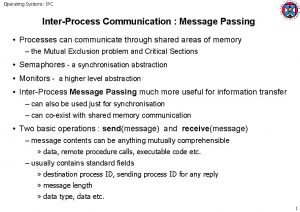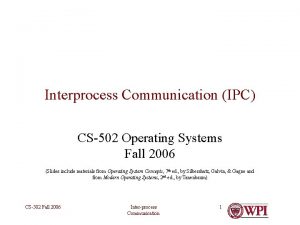Interprocess Communication IPC CS 537 Intoduction to Operating





![Simple Examples • Sharing memory char* share. Mem[80]; // memory accessible to A and Simple Examples • Sharing memory char* share. Mem[80]; // memory accessible to A and](https://slidetodoc.com/presentation_image_h/0bd4435eb115c62707cdf32b3cdc7092/image-6.jpg)








![Timeout Example char msg[80]; int err. Code; set. Timeout(250); // 250 ms before timing Timeout Example char msg[80]; int err. Code; set. Timeout(250); // 250 ms before timing](https://slidetodoc.com/presentation_image_h/0bd4435eb115c62707cdf32b3cdc7092/image-15.jpg)










![Using Unix Pipes int main(int argc, char** argv) { int fd[2]; // 2 ints, Using Unix Pipes int main(int argc, char** argv) { int fd[2]; // 2 ints,](https://slidetodoc.com/presentation_image_h/0bd4435eb115c62707cdf32b3cdc7092/image-26.jpg)












- Slides: 38

Interprocess Communication (IPC) CS 537 - Intoduction to Operating Systems

Cooperating Processes • How do we let processes work together? • Possible solutions: – share memory • fast and simple • how to keep secure and synchronized? – message passing • • no shared memory send and receive messages more difficult to program makes security and synchronization simpler

Shared Memory • Easiest way for processes to communicate – at least some part of each processes’ memory region overlaps the other processes’ memory process A shared memory • If A wants to communicate to B – A writes into shared region – B reads from shared region • Can use simple load and stores – no special commands for communication process B

Shared Memory • How much memory to share? – none (this really isn’t shared memory : ) – some – all • How to allocate shared memory? – automatically on creation of a child • parent and child share memory – explicitly through system calls • a process requests OS to set up a shared memory segment • a process makes another system call to share the memory • No matter how it’s shared, the memory resides in user space

Shared Memory • Two major disadvantages to shared memory – synchronizing access • B needs to know when A has written a message into the shared memory – so B can read the message • A needs to know when B has read the message – so A can write another message – security • possible for A or B to accidentally write over a message – program bug • B may maliciously read or write some part of A’s memory that it shares
![Simple Examples Sharing memory char share Mem80 memory accessible to A and Simple Examples • Sharing memory char* share. Mem[80]; // memory accessible to A and](https://slidetodoc.com/presentation_image_h/0bd4435eb115c62707cdf32b3cdc7092/image-6.jpg)
Simple Examples • Sharing memory char* share. Mem[80]; // memory accessible to A and B int value; // more memory shared by A and B Process A Process B strcpy(share. Mem, “hello”); strcpy(my. Buf, share. Mem); value = 23; my. Value = value; • notice that A and B communication does not involve the operating system or any special calls – just reading and writing regular memory • also notice, if B performs it’s read of share. Mem before A writes to it, B will get garbage – we’ll cover synchronization in a week

Shared Memory Review • Intuitive to program – just access memory like any other program • High performance – does not get the OS involved • Must synchronize access to data – more on this later • Have to trust other processes sharing the memory

No Shared Memory • In the absence of shared memory, the OS must pass messages between processes – use system calls to do this • Several major techniques for doing this – pipes, message passing, ports • Several major issues to consider

IPC Issues • direct or indirect communication – naming issues • synchronous or asynchronous communication – wait for communication to happen or assume it does • automatic or explicit buffering – how to store messages • fixed messages or variable sized – greatly affects overhead and memory requirements

Indirect vs. Direct Naming • Direct Naming – explicitly state which process to send/receive – code fragment • send(Process P, char [] message, int size) • receive(Process P, char [] message, int size) – must know before hand exactly where to send/receive message

Indirect vs. Direct Naming • Indirect naming – use “mailboxes” – processes extract messages from a mailbox • may grab a message from a specific process • may grab a specific type of message • may grab the first message – send/receive to/from mailboxes – code fragment • send(Mailbox A, char [] message, int size) • receive(Mailbox A, char [] message, int size)

Synchronization • Blocking send – suspend sending process until message received • Non-blocking send – resume process immediately after sending message • Blocking receive – suspend receiving process until data is received • Non-blocking receive – return either a message or – null if no message is immediately available

Synchronization Trade-Offs • Blocking – guarantees message has been delivered – drastically reduces performance • Non-blocking – much better performance (hides latency of message sending) – could cause errors if messages are lost

Timeout • One other option is to use timouts – typically with a blocking send/receive • If a process blocks for a certain amount of time, call returns with a special error code – indicates message wasn’t sent/received • User can write special code to deal with this case
![Timeout Example char msg80 int err Code set Timeout250 250 ms before timing Timeout Example char msg[80]; int err. Code; set. Timeout(250); // 250 ms before timing](https://slidetodoc.com/presentation_image_h/0bd4435eb115c62707cdf32b3cdc7092/image-15.jpg)
Timeout Example char msg[80]; int err. Code; set. Timeout(250); // 250 ms before timing out if((err. Code = recv(mailbox, msg, 80)) == TIME_OUT) { // handle this case } else if(err. Code < 0) { // some kind of error // handle error } …

Buffering • Buffering allows messages to be saved and read or transmitted later • Requires sufficient memory to store messages • Can drastically improve performance of applications

Types of Buffering • Zero Capacity – no buffering at all – must be “listening” when a message comes in • Bounded Capacity – some max, n, of messages will be buffered – be careful when queue gets full • Unbounded Capacity – no limit to the number of messages – not usually very realistic assumption – this is not very realistic, buffers usually have finite capacity

Buffering Example PA PB user space recv msg X (time: 25) send msg X (time 10) kernel space send msg Y (time: 15) X Y bounded buffer Note: OS stores message so that PA can go back to work instead of waiting for PB to do a receive

Bounded Buffers • What to do if a bounded buffer gets full? – make the send call fail • return an error code to the user program – make the send call block • even if it normally wouldn’t do so

Message Length • Fixed Length – how big to make the messages? • Variable Length – how to handle buffering?

Fixed Length Messages • makes buffering simpler – know exact size needed for each message • to send a large message, break to small bits • can hurt performance for large messages – overhead of creating many small messages • What size? – too big wastes buffering space in memory – too small hurts performance for large messages – some systems provide several message sizes

Variable Length Messages • Provides great flexibility – send as much data as you want and only incur overhead of setting up message once • How do you guarantee buffering space? – what if buffer is almost full when a new, large message comes in? – what if one message is larger than entire buffer? • Consider variable size up to some max – this is one of the most common methods

Common Message Passing Methods • Pipes – direct connection between 2 or more processes • Message Queues – shared buffer in OS where processes place and retrieve messages • Ports – process specific buffer in OS

Pipes • Conceptually – a pipe is a link between two processes – one process writes into one end of the pipe – another process reads out of the other end • messages are read in the order they are written flow Psender msg 3 msg 2 msg 1 pipe Preceiver – for both processes to be able to read and write simultaneously, two pipes are necessary

Pipes • Unix implementation – a pipe is represented as a file without any data • the “file” is created using the pipe() system call – when the file is created, the operating system allocates kernel space for storing messages • no messages actually go to a file – any read() or write() system call operations on a pipe, actually read and write to the reserved kernel space
![Using Unix Pipes int mainint argc char argv int fd2 2 ints Using Unix Pipes int main(int argc, char** argv) { int fd[2]; // 2 ints,](https://slidetodoc.com/presentation_image_h/0bd4435eb115c62707cdf32b3cdc7092/image-26.jpg)
Using Unix Pipes int main(int argc, char** argv) { int fd[2]; // 2 ints, one for reading, one for writing int pid; // will be used for a fork later pipe(fd); // open 2 pipes: fd[0] - read, fd[1] - write pid = fork(); if(pid == 0) { // child process - receiver char buf[80]; read(fd[0], buf, 80); printf(“%sn”, buf); } else // parent process - sender write(fd[1], argv[2], 80); return 0; }

Named Pipes (FIFO) • Problem with pipes: only way for two processes to share a pipe is to share a common ancestry – no way for two unrelated processes to communicate • Solution: named pipes • A named pipe is represented as a special file – file is created using mknod() or mkfifo() system calls – these files contain no data

Named Pipes (FIFO) • Using named pipes – must be opened - like a regular file • use the open() system call • this creates space in the kernel for reading and writing to – from here it looks just like a regular pipe • use read() and write() to receive/send messages – user can close the pipe when finished using it • use the close() system call

Pipes • Pipe characteristics – indirect naming • multiple processes can read and write a pipe – asynchronous or synchronous • determined at creation time of pipe – bounded buffer • pipe only has a certain amount of capacity – message length is variable up to some maximum

Message Queues • Conceptually – a message queue is a repository for named messages – these messages can be removed in any order based on their name • very similar to a post office – all messages get sent to the post office – multiple people can enter the post office – each person has their own box at the post office

Message Queues • Unix System V implementation – use the msgget() system call to allocate space in the kernel for a group of messages • it is possible to create separate queues – each message sent to a specific group, may contain a type field • type field can be used to implement priority, specific processes to receive message, etc. • to send a message, use the sendmsg() system call • maximum number of messages in queue is limitted – request to receive message may contain a specific type • usually retrieve the first message in queue of a specific type • if no type specified, grab the first message in queue

Message Queues • Message queue is usually implemented as a list – so it’s not a queue in the true data structure sense • Example PA PB PC user space 2 1 head 2 type: 0 msg: hello next: 5 3 3 type: 1 msg: spot next: 4 4 type: 0 msg: bye next: NULL kernel space

Message Queues 1) PA create a message queue - initially it is empy 2) PA sends a message (type 0) to the queue - node added to list 3) PC sends a message (type 1) to the queue - node added to list 4) PB sends a message (type 0) to the queue - node added to list 5) PB receives a message (type 1) from the queue - queue is searched for first type 1 message - message is removed from queue

Message Queues • Message queue characteristics – indirect naming • multiple processes can read and write to same queue – asynchronous or synchronous • determined at creation time of queue – bounded buffer • buffer only accepts a maximum number of messages – fixed size header, variable length messages • a fixed amount of space is allowed for all the messages in a queue - can’t exceed this

Ports • Conceptually – a port has a certain amount of memory allocated for it – any message sent to a specific port is put into the memory for that port – each port is associated with a single process only – a port is identified by a single integer number – messages are sent to specific ports port for A PA PB user space kernel delivers the message to kernel first kernel space

Ports • A process can have multiple ports – which port a message is delivered to depends on which one it is intended for • The memory for each port can be located in either the kernel or the user space – more flexible if in user space – more copying required if in user space • message gets copied to kernel and then to port

Ports • Sending a message – you send the message to a specific port – send(port, msg, size); • Receiving a message – indicate which port to receive a message from – recv(port, buf, size); • More details on this is left to a networking course

Ports • Port characteristics – direct naming • a message gets delivered to a specific process • the process associated with the port – asynchronous • assume message sent once given to OS • can simulate synchronous – bounded buffer • port only has a certain amount of capacity – message length is variable up to some maximum
 Interprocess communication in linux
Interprocess communication in linux Java interprocess communication example
Java interprocess communication example Message passing os
Message passing os Interprocess communication in os
Interprocess communication in os Race condition in interprocess communication
Race condition in interprocess communication Interprocess communication in distributed system
Interprocess communication in distributed system Android interprocess communication
Android interprocess communication Producer-consumer problem
Producer-consumer problem Ipc operating system
Ipc operating system Boost interprocess
Boost interprocess Sda hymnal he leadeth me
Sda hymnal he leadeth me Cs 537
Cs 537 Buddy system memory allocation
Buddy system memory allocation Cs 537
Cs 537 Cs 537
Cs 537 Cs 537
Cs 537 537-317-757
537-317-757 Communication primitives in distributed operating system
Communication primitives in distributed operating system Qa ipc
Qa ipc System v ipc
System v ipc Cpc ipc
Cpc ipc Ipc 4101/26 material
Ipc 4101/26 material Ipc 2221
Ipc 2221 Xyx-ipc
Xyx-ipc System v ipc
System v ipc Ipe ipc
Ipe ipc Examples of ipc systems
Examples of ipc systems Bioaggregate
Bioaggregate Ipc class 3
Ipc class 3 Ipc nacional empalme ipim
Ipc nacional empalme ipim Netflix microservices stack
Netflix microservices stack Ipc in microbiology
Ipc in microbiology Notes on ipc
Notes on ipc Ipm plants
Ipm plants Who guidelines on core components of ipc programmes
Who guidelines on core components of ipc programmes Ipc distributed systems
Ipc distributed systems Knowledge harvest ipc
Knowledge harvest ipc Ipc creat
Ipc creat Contoh penerapan ipe dan ipc
Contoh penerapan ipe dan ipc

